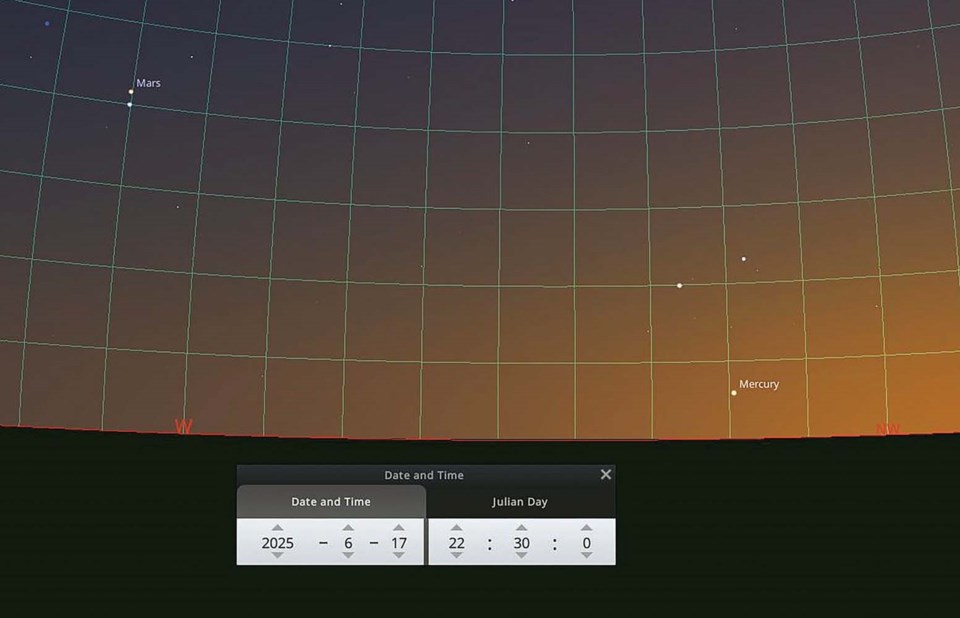June begins with Venus at its maximum western elongation from the Sun –– about 46 degrees (to the right). That’s about twice the span of your hand at arms-length with fingers/thumb fully spread out. While that’s well away from the Sun, the part of the ecliptic containing Venus, Saturn and Neptune is quite low to the eastern horizon; Venus will only be 5 degrees above the horizon and just about due east. If you look at about 04:00 June 1, the good news is that with an unobstructed view to the east, you can’t miss it.
Bonus #1: if you look about twenty degrees to the right of Venus and about twice as high above the horizon, you should be able to see another reasonably bright object that won’t look particularly twinkly. Congratulations, that’s Saturn, which won’t be as bright as it usually is because it just passed its fall equinox so that its 15-year-long southern summer season is beginning. Saturn’s rings are exactly lined up around its equator but are only about a kilometre or so thick; at equinoxes its edge-on rings –– and the sunlight they reflect –– effectively disappear from our view.
Bonus #2: With a good pair of binoculars and either a good steady tripod or firm support from something solid, if you look not quite two degrees (two thumb widths) left of Saturn and just a bit above, you may see another faint not-twinkly object that may look a very pale blue. There’s also a star close to it and about the same distance away from Saturn but slightly higher and somewhat brighter. The field-of-view on my 10x binoculars is about 7 degrees so if I were to center Saturn, the pair described would be less than halfway to the upper left edge of the field. The star is about magnitude 6.3 –– just below naked-eye visibility and the other object is magnitude 7.8 –– well within the range of 10 x 50mm binoculars. So, what is that faint pale spot? Neptune, our outermost planetary neighbour! Full disclosure: I’ve never actually picked Neptune out of the sky myself but with Venus and Saturn as guide stars, I’m really going to try this time.
About the same time as the planetary action in the morning, a nearly first-quarter Moon passes only 0.2 degrees north of Mars but it’s just below the western horizon for us and not visible, unfortunately. Later that day –– about 23:00, it scoots eastward just above Regulus in Leo.
Last month I described how Mars had finished its loop through Gemini and started heading east towards Leo. Around the middle of June about 23:00, you can watch Mars pass Regulus, the bright star in Leo and continue east. The bright pair in Gemini, Castor and Pollux, will be low in the northwest and Regulus will be about 15 degrees above the horizon due west. For anyone who wants to impress kids with how planets move, this’ll do the trick, believe me. Mars is moving about half a degree eastwards each night and with a bright reference star nearby it’s truly impressive.
Bonus #3: While you’re watching Mars pass Regulus at mid-month, look below Castor and Pollux on the western horizon; that somewhat brighter object moving left below them close to the horizon is the planet Mercury.
Yes, we’re still waiting for the predicted flareup of T Corona Borealis, it’s like watching paint dry. Check its brightness goings-on and many other events at www.spaceweather.com.
The next SCAC monthly meeting will be at the Sechelt Library, June 13, at 7 p.m. The speaker will be Dr. Nicole Vassh of UBC’s Tri-University Meson Facility –– TRIUMF. Her topic will be the current theories of the formation of heavy elements in the universe.



